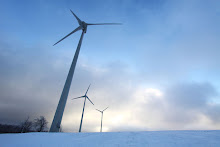Electric distribution is the movement of electricity from the interconnection with the transmission system through the end-use consumer's meter. If transmission is considered the highway on which electricity travels long distances, the distribution system can be considered the streets and avenues that connect end-use customers to it. Generally, distribution refers to electric systems with voltages lower than 60 kV (although some utilities define distribution as lower than 40 kV). Distribution systems are often divided into primary systems (higher voltages) and secondary systems (lower voltages). Ultimately, the voltage at which electricity is delivered to an end-use consumer must be transformed to the voltage used by the consumer's electrical devices, which for smaller customers is the common 120 V we are used to seeing in our homes and offices. All distribution lines in the United States distribute AC power.
Types of Distribution Systems:
Radial Feed
A radial feed is simply a single line from a transformer out to a number of customers. While the lowest cost of the options, radial feeds do suffer from the fact that loss of cable, primary supply or the transformer will result in loss of service to all customers on that feed. Also, radial circuits must be de-energized to perform routine maintenance and services.
Loop Feed
A loop feed serves customers off a loop that is connected to the primary feed at two ends. This costs more than a radial system since duplicative equipment is required, but does provide the capability of isolating faults within the loop and continuing to feed all customers except those on the section with the fault. The reliability of both radial feeds and loop feeds can be enhanced by adding primary distribution feed to the circuit.
Network System:
A network system connects multiple primary feeds and interconnects multiple distribution circuits in the form of a grid. While network systems provide the highest form of reliability since customers can be served in multiple ways, they are also expensive because of the costs of duplicative equipment, transformers and specialized network protective equipment. Networks are generally used in downtown urban areas with highly dense critical loads.
The Meter
The last key component of the distribution system is the meter located at each customer location. Without the meter, customers cannot be billed and energy companies cannot be paid. Metering is currently undergoing significant transition. Until the last 15 years, almost all meters were read once a month by a meter reader who recorded usage at each customer location. Meter data as generally limited to KWh used and for larger customers maximum kW. Since then we have become accustomed to increasingly sophisticated meters at reduced costs. Now many utilities depend on meters that can be read remotely and make meter data available on a real-time basis. Higher-end meters can be used to record large amounts of useful data including energy usage by time period, demand by time period and various measures of power quality. In the near future, the electric meter may evolve into a services gateway that will allow two-way communication between energy providers and consumers, opening up new ways for energy companies to maximize the efficiency of supply and customers to participate in energy markets.
skip to main |
skip to sidebar
Energy Forecast & Updates
